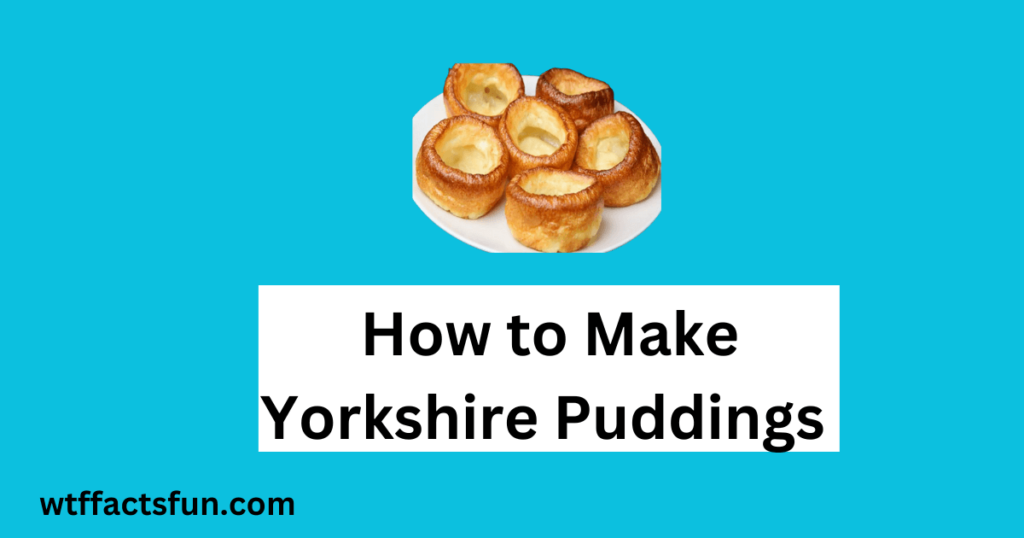
Table of Contents
How to Make Yorkshire Puddings
How to Make Yorkshire Puddings: Yorkshire puddings are a quintessential component of a traditional British roast dinner, particularly popular in the UK. Known for their crispy exterior and soft, fluffy interior, these delightful puddings are surprisingly simple to make. This detailed guide will walk you through the ingredients, equipment, step-by-step preparation, and tips to achieve perfect Yorkshire puddings every time.
Ingredients
To make Yorkshire puddings, you will need the following ingredients:
- 140g plain flour
- 4 large eggs
- 200ml whole milk
- 200ml water
- Pinch of salt
- Sunflower oil or beef dripping for the tin
Equipment
- A 12-hole muffin tin or Yorkshire pudding tray
- Mixing bowl
- Whisk
- Jug (for easy pouring)
- Oven mitts
Step-by-Step Preparation
- Preheat the Oven: Begin by preheating your oven to 220°C (fan 200°C)/425°F/gas mark 7. The oven needs to be very hot for the puddings to rise properly.
- Prepare the Batter:
- In a mixing bowl, add the 140g of plain flour and a pinch of salt.
- Crack the 4 large eggs into the bowl and whisk until smooth.
- Gradually add the 200ml of whole milk and 200ml of water, whisking continuously until the batter is completely smooth and has the consistency of single cream. If you prefer, you can prepare this batter ahead of time and refrigerate it for up to 24 hours.
- Heat the Oil:
- Pour a small amount of sunflower oil or beef dripping into each hole of your muffin tin or Yorkshire pudding tray. The oil should just cover the bottom of each hole.
- Place the tin in the preheated oven and heat the oil until it is very hot. This should take about 10 minutes. The oil needs to be smoking hot to ensure the puddings rise properly.
- Pour the Batter:
- Carefully remove the hot tin from the oven using oven mitts.
- Quickly pour the batter into the hot oil, filling each hole about halfway. The batter should sizzle as it hits the oil.
- Bake the Puddings:
- Immediately return the tin to the oven. Bake the puddings for 20-25 minutes without opening the oven door. Opening the door can cause the puddings to deflate.
- The puddings are done when they are well-risen, golden brown, and crispy on the outside.
- Serve Immediately: Yorkshire puddings are best served straight from the oven while they are still hot and crispy. They can be enjoyed on their own, with gravy, or as part of a traditional roast dinner.
Tips for Perfect Yorkshire Puddings
- Consistent Batter: Ensure the batter is smooth and has a consistent single cream-like texture. Lumps in the batter can prevent proper rising.
- Resting the Batter: Allowing the batter to rest for at least 30 minutes (or overnight in the fridge) can help the puddings rise better.
- Hot Oil: The oil in the tin must be smoking hot before adding the batter. This is crucial for achieving the characteristic rise.
- Oven Temperature: Maintain a high oven temperature and avoid opening the oven door during baking to prevent the puddings from collapsing.
- Serving: Serve the puddings immediately to enjoy their crispiness. They tend to soften as they cool.
Variations and Serving Suggestions
- Traditional Serving: Yorkshire puddings are traditionally served with roast beef and gravy but can accompany any roast meat.
- Filled Puddings: For a twist, serve the puddings filled with savory ingredients like sausages (toad in the hole), minced beef, or vegetables.
- Sweet Yorkshire Puddings: Experiment with sweet versions by adding a little sugar to the batter and serving with jam, fruit, or custard for dessert.
Conclusion
Making Yorkshire puddings is a straightforward process that requires a few simple ingredients and careful attention to detail. By following this guide, you can create perfectly risen, crispy, and delicious Yorkshire puddings that will delight your family and guests. Enjoy this classic British treat as part of your Sunday roast or with a variety of fillings and accompaniments.
Read also:
16 Fun Facts About Diamonds: Sparkling Marvels of Nature
15 Fascinating Facts About Shoes: Unveiling the Secrets of Footwear